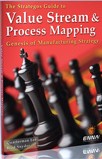Imitation or Innovation
Implementation of Lean Manufacturing is a rather murky subject. Most firms stumble
through the implementation with trial and error. Others rely on endless
Kaizen events. Some believe that
Value Stream Mapping is all that is
necessary.
There is a dearth of information and some of what is available is misleading or impractical.
For example, one published approach emphasizes phases of:
1. Stability
2. Continuous Flow
3. Standardized Work
4. Pull Systems
5. Level Production
6. Continuous Improvement
These phases of lean are supposed to roll through the entire plant one after another like
tsunamis. For most firms this is unrealistic. It ignores the interactions and
systemic nature of Lean Manufacturing.
This is what Barry Richmond calls "List Thinking." List thinking is pervasive. Indeed, we
have our own list of "Core Disciplines" on our
"Lean Manufacturing Principles page." "Do these
things [list] and everything will be OK."
Imagine a physician with a list of the top twenty drugs. He prescribes the same list to every
patient, regardless of symptoms. The thought does not inspire confidence and the approach is
unlikely to work on a complex system like the human body-mind. Nor will it work for a factory.
List thinking is especially problematic when implementing. All the elements in the Laundry
List at right have value in some situations. However, the list gives no guidance for priorities,
precedence or impact. Indeed, it cannot because each factory and situation is unique.
Examining this topic strategically and
systemically raises several questions:
-
Do we need the entire list of "Tools and Techniques?"
-
If not, which do we employ?
-
Which elements come first?
-
Do we implement Lean Manufacturing company-wide or in focused areas?
-
How does Kaizen fit into the picture?
-
How detailed should the plans be?
-
How long will it take?
- How do we know when we are really Lean?
This and subsequent pages examine these issues and address the questions. We start first with
an appropriate "Mental Model" to
structure our thinking and build a frame of reference.
Another key to effective planning is to identify appropriate phases. We suggest:
I. Core Disciplines
II. Consolidation
III. Continuous Improvement
The initial challenge is to plan for Phase I. This starts with an
assessment. Then the appropriate
"core disciplines" are selected and prioritized.
Strategies are developed and project plans worked out.
We urge you to reflect on these issues and the "Mental
Model". Our additional pages detail a procedure to develop a Lean Manufacturing
Implementation Strategy and an action plan.
|





